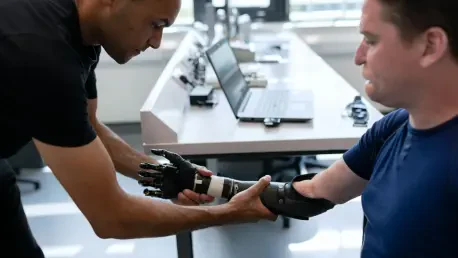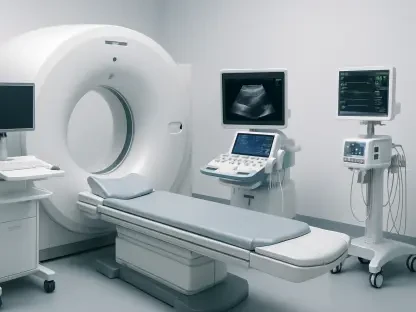As the global population ages and disabilities become increasingly prevalent, the need for effective rehabilitation methodologies is more pressing than ever. Robotics holds promise in addressing these challenges, offering innovative ways to assist individuals with motor, sensory, and cognitive impairments. While the potential benefits are undeniable, the integration of robotics into clinical settings faces significant hurdles. Understanding these challenges and exploring viable solutions could determine whether robotics becomes a mainstay in modern rehabilitation practices.
The Promise and Challenges of Robotics in Clinical Environments
Advancements in Robotics for Rehabilitation
Technological innovations have enabled the development of robotics designed to aid in rehabilitation for those with disabilities, offering tailored therapies to meet diverse needs. These emerging technologies are equipped with capabilities to assist in exercises aimed at motor skill recovery, making them invaluable in therapeutic regimens. Yet, despite these advancements, the translation from innovation to clinical adoption is not smooth. Scientific validity remains under scrutiny, as healthcare providers require robust evidence demonstrating the cost-effectiveness and therapeutic efficiency of these robotic solutions. Regulatory pathways also challenge developers, with the need to meet stringent standards for medical devices complicating the pace of innovation.
Moreover, the ethical considerations associated with robotics in healthcare add layers of complexity. Concerns surrounding patient privacy, autonomy, and data security must be addressed to ensure ethical deployment. Cultural resistance also clouds the adoption of robotics in clinical environments. The skepticism of healthcare practitioners regarding the efficacy and reliability of these technologies sometimes impedes their integration. This resistance is compounded by a lack of familiarity and training on how to incorporate robotic-assisted therapies into existing clinical practices.
Barriers to Clinical Implementation
Incorporating robotics into rehabilitation requires a reevaluation of existing clinical models and workflows, which necessitates significant systemic changes. One major obstacle is the economic feasibility for healthcare institutions to invest in these technologies. Initial costs for acquiring, maintaining, and upgrading robotic systems can be prohibitive, making it challenging for many facilities to justify the expense without guaranteed returns on investment. This economic burden is further exacerbated by uneven funding structures across different regions, which affect institutions’ willingness to adopt new technologies.
Additionally, the integration of robotics necessitates workforce training and education, which presents a further financial and logistical challenge. The skills required to operate and interpret data from these sophisticated machines are often beyond the current expertise of many healthcare practitioners, necessitating additional training programs. Furthermore, regulatory constraints loom large, with varying standards and requirements creating uncertainty for developers and clinicians alike. This inconsistency can delay the rollout of potentially life-changing robotics solutions across healthcare systems.
Initiatives to Address Integration Hurdles
The Fit4MedRob Initiative
In light of these barriers, the Fit for Medical Robotics (Fit4MedRob) Initiative has emerged to bridge the gap between technological innovation and practical application within clinical environments. By proposing large-scale pragmatic trials, this initiative aims to generate empirical data that validates both the effectiveness and sustainability of existing robotic solutions. This evidence-based approach endeavors to build confidence among clinicians and decision-makers, providing tangible proof of the benefits robotics can offer if integrated into standard care practices.
Before trials commence, comprehensive surveys gather insights from healthcare practitioners and patients to tailor designs to real-world therapeutic settings. Understanding the varied needs across different stages of diseases and environments—from hospitals to home care—is pivotal for creating relevant designs. These insights guide trial structures, ensuring that they address genuine user needs and adapt to the diverse therapeutic contexts in which robotic technologies may be employed.
Future Models for Integration
Beyond technical and empirical validation, new organizational paradigms must promote seamless incorporation of robotic-assisted rehabilitation into clinical workflows. The Fit4MedRob Initiative is expected to outline these models, leveraging insights from trial outcomes to recommend pathways for change. Anticipated solutions include optimizing clinical workflows to make room for robotic-assisted therapies, recalibrating staff roles to better utilize these technologies, and incorporating robust training programs to eradicate knowledge gaps.
Moreover, the initiative aims to suggest regulatory policy updates to streamline the approval and implementation processes for new technologies. Such improvements would ensure that beneficial robotic therapies can be more rapidly and widely adopted to enhance rehabilitation outcomes. Embracing a forward-thinking approach could pave the way for robotics in revolutionizing clinical rehabilitation, potentially transforming lives and enhancing disability care standards.
Looking Forward: Transforming Rehabilitation Practices
As the global population continues to age and disabilities become increasingly common, the demand for effective rehabilitation methods is more urgent than ever before. Robotics presents a promising solution to these challenges by providing innovative ways to assist individuals who face motor, sensory, and cognitive impairments. The potential advantages of integrating robotics into rehabilitation are clear; however, barriers exist that could hinder their full incorporation into clinical settings. To ensure that robotics can be a staple of modern rehabilitation practices, it’s crucial to comprehend these obstacles and explore practical solutions. These challenges might include technological limitations, costs, regulatory concerns, and the need for specialized training. By addressing these issues, we can determine the extent to which robotics will become an integral component in the rehabilitation landscape, helping to improve the quality of life for many individuals as global demands continue to rise.









